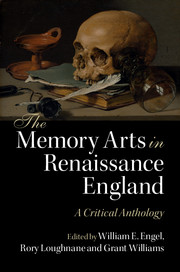Book contents
- Frontmatter
- Dedication
- Contents
- List of figures
- Acknowledgements
- A note on abbreviations
- Introduction
- PART I The art of memory
- PART II Rhetoric and poetics
- PART III Education and science
- PART IV History and philosophy
- PART V Religion and devotion
- PART VI Literature
- Introduction to Part VI
- POETRY
- PLAYS AND PROSE
- VI.11 Thomas Nashe, The Unfortunate Traveller (1594)
- VI.12 William Shakespeare, selected works
- VI.13 John Webster, selected works
- VI.14 Thomas Tomkis, Lingua: or the Combat of the Tongue (1607)
- VI.15 Mary Wroth, Urania (1621)
- VI.16 John Earle, Microcosmography (1628)
- VI.17 John Jones, Adrasta (1635)
- VI.18 Thomas Browne, Hydriotaphia, Urn-Burial (1658)
- VI.19 Anon., Crackfart and Tony; or, Knave and Fool (1680)
- VI.20 John Bunyan, The Pilgrim's Progress (1681)
- Index
- References
VI.15 - Mary Wroth, Urania (1621)
from PLAYS AND PROSE
Published online by Cambridge University Press: 05 August 2016
- Frontmatter
- Dedication
- Contents
- List of figures
- Acknowledgements
- A note on abbreviations
- Introduction
- PART I The art of memory
- PART II Rhetoric and poetics
- PART III Education and science
- PART IV History and philosophy
- PART V Religion and devotion
- PART VI Literature
- Introduction to Part VI
- POETRY
- PLAYS AND PROSE
- VI.11 Thomas Nashe, The Unfortunate Traveller (1594)
- VI.12 William Shakespeare, selected works
- VI.13 John Webster, selected works
- VI.14 Thomas Tomkis, Lingua: or the Combat of the Tongue (1607)
- VI.15 Mary Wroth, Urania (1621)
- VI.16 John Earle, Microcosmography (1628)
- VI.17 John Jones, Adrasta (1635)
- VI.18 Thomas Browne, Hydriotaphia, Urn-Burial (1658)
- VI.19 Anon., Crackfart and Tony; or, Knave and Fool (1680)
- VI.20 John Bunyan, The Pilgrim's Progress (1681)
- Index
- References
Summary
About the author
Mary Wroth (1587?–1651/3) was the eldest daughter of Robert Sidney, brother to the illustrious Philip Sidney and Mary Herbert after whom she was most likely named. Wroth has earned the double distinction in literary history of being the first known English woman to compose a sonnet cycle and the first known English woman to compose a romance.
About the text
Wroth's title The Countess of Montgomery's Urania honours her relative and friend Susan de Vere and echoes Sidney's noble formulation the Countess of Pembroke's Arcadia. Indeed, Wroth pays extensive literary tribute to her uncle insofar as both texts are long, drawn-out prose romances with pastoral elements and interpolated lyric poems and songs. Her romance may also be read as an early roman à clef, since Pamphilia's relations and situations strike similar chords with Wroth's life, while the emperor Amphilanthus squares with Wroth's lover, William Herbert. Mustering together hundreds of characters and chasing an array of convoluted plots and subplots, the narrative centres on several noble and royal houses, whose family members undergo trials and tribulations and separations and reunifications in a fictional world of European courtliness and chivalry. The story of Pamphilia's long-suffering loyalty to the philandering Amphilanthus confers a kind of frame upon the narrative. Pamphilia braves a series of enchantments climaxing in the ‘hell of deceit’ episodes in book IV, from which the two excerpts below are taken. Interrupted by considerable action, the parallel scenes focus on each lover's distressing vision of the other's magical imprisonment and surgery. The episodes rescript the House of Busirane episode that brings book III of Spenser's Faerie Queene to its climax: there Britomart witnesses the enchanter incising letters into Amoret's dissected heart, the grisly tableau figuring forth the tortured mental interiority of the victim of love melancholy. Wroth's printed romance is unfinished, ending in mid sentence, but its narrative continues in an unpublished manuscript. It caused such a furor because of its reference to actual people that she suspended publication and destroyed the copies.
The arts of memory
The Petrarchan and Ovidian iconography of the heart, upon which so much of Renaissance erotic language depends, operates as a distinctive yet significant memory art within the culture's courting and amorous rituals.
- Type
- Chapter
- Information
- The Memory Arts in Renaissance EnglandA Critical Anthology, pp. 340 - 343Publisher: Cambridge University PressPrint publication year: 2016



